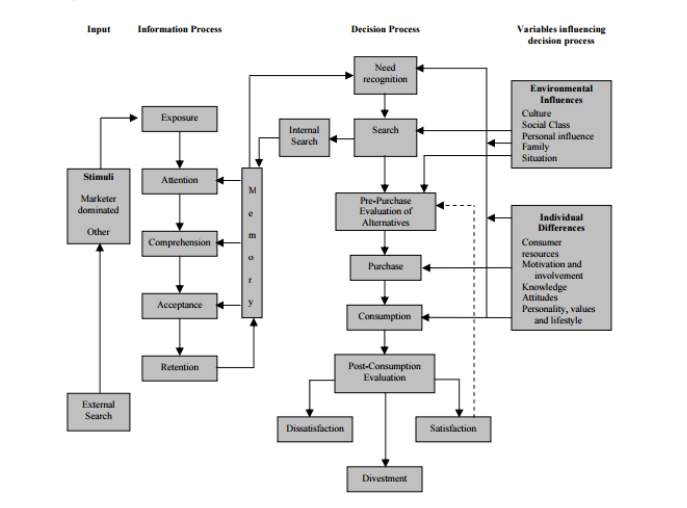What is Consumer Behaviour?
Consumer behaviour is defined as the study of the consumer and the exchange processes involved in acquiring, consuming and disposing of goods, services to satisfy their needs and desires (Linehan, 2008). In other words, consumer behaviour is influenced by lifestyle, personality, knowledge, motivation, attitudes, beliefs, and feelings. Linehan (2008) also suggests that the behaviour of a consumer has three activities; acquisition, consumption, and disposition. Acquisition being the activities leading to the actual purchase, consumption is how, where and under what circumstances the consumer will use the product, and disposition this being the action by which the consumer disposes of the products which they have consumed.
A consumer is generally thought of as an individual who recognises a need or desire, makes a purchase, and then disposes of the product during the three stages in the consumption process. The term consumer behaviour is used to describe two separate consumer entities; the personal consumer and the organisational consumer. The personal consumer purchases products for his/her own use, intended for use in the household, or as a gift. In each of these situations the product is purchased for final use by individuals, who are also known as ultimate consumers. The organisational consumer includes companies, schools, hospitals, etc… purchase products that are required to run their organisation. (Schiffman, Hansen and Kanuk, 2008). The decisions of all consumers are influenced by several individual characteristics that are linked to the consumers’ individual needs (Chaudhuri).
Consumer decision making process
Consumer decision making is defined as the process by which consumers identify their needs/desires, collect information on product/service, evaluate alternatives, and make the purchase decision. Psychological and economic factors determine these actions, and are influenced by cognitive and emotional factors such as family, friends, moods, role models, and advertisers (Schiffman, Hansen and Kanuk, 2008).
 FIGURE 1: Model of Consumer Decision-Making (Schiffman, Hansen and Kanuk, 2008, p 75)
FIGURE 1: Model of Consumer Decision-Making (Schiffman, Hansen and Kanuk, 2008, p 75)
Input
In this particular consumer behaviour model the input componant draws on external influences to serve as sources of information regarding a product and shape a consumer’s product-related values, behaviour and attitudes.
The firms marketing efforts are a straight-forward attempt to inform consumers of their products and attempt to influence them into ourchasing said products. These inputs to the consumers decision making process form a clear marketing strategy employed by the company, that is a combination of the product (including its packaging), media advertisment, pricing policy and a carefully selected set of distribution channels to best suit their product and move the product from manufacturer to consumer (Schiffman and Kanuk, 2009).
The sociocultural environment, also has a huge influence on the consumer. Sociocultural influences consist of a vast range of non-commercial influences. These influences such as social class and culture play a major role in how consumers evaluate products and make their purchasing decisions.
Process
The consumer decision-making model, illustrated above, displays a simplified model of a much more complex process. The process of the model is concerned with how consumers make decisions. The psychological field represents the internal influences that affect a consumers’ decisions, such as motivations, learning, personality, and attitudes. (Schiffman, Hansen and Kanuk, 2008). The decision-making process consists of three stages, as illustrated in figure 1, pictured above.
- Need recognition
- Pre-purchase search
- Evaluation of alternatives
The need recognition stage is most likely to occur when a consumer recognises that they have a need for something. It is because of this that companies intentionally market their products to cause consumers to recognise a problem and attempt to reach, inform, and persuade consumers to purchase their products (Linehan, 2008). They often attempt to cause consumers to believe that their product is outdated and that they need the company’s product (Schiffman, Hansen and Kanuk, 2008). If the need to purchase the product is strong enough the consumer may enter the second stage of the decision-making process, which is the pre-purchase search.
The second stage of the decision-making process, which is the pre-purchase search will begin if/when the consumer recognises a need that they believe will be satisfied with the purchase and consumption of the product. (Schiffman, Hansen and Kanuk, 2008). The consumer may begin to actively gather information on the product in question, by looking researching online, in stores and by speaking to friends. (Kotler and Keller). Several factors will affect a consumers’ pre-purchase search such as experience, value-related considerations, social acceptability, personality, and many factors about the product itself. (Schiffman, Hansen and Kanuk, 2008).
The third stage is evaluation of alternatives. This is the stage in which consumers evaluate the alternatives that they have identified to solve their problem (Linehan, 2008). Through an evaluation procedure, the consumer can form opinions towards the products they are considering and form a belief on where each product stands in regards to their set of needs. It is at this stage that many other factors need to be considered when choosing a product such as price, convenience, skills, and equipment needed.
Output
Figure 1, also shows post purchase behaviour. There are two stages in this post purchase behaviour.
- Purchase decision
- Post-purchase evaluation
The evaluation of alternative products can affect the consumers purchase decision and may have led the consumer to form preferences for certain products or a certain brand of product. Per Linehan (2008) consumers generally make three types of purchases; trial purchases, repeat purchases, and long-standing commitment purchases. A trial purchase is a first-time buy to evaluate the product. Repeat purchase behaviour is related to brand loyalty. Repeat purchases generally indicates that the product meets with the customers’ expectations to an acceptable standard (Linehan, 2008).
Finally, in the post-purchase evaluation stage the consumers evaluate the product after it has been consumed. They evaluate the consciences of their purchase and ultimately the disposal of the waste remaining from their purchase. The main outcome of this stage is the reduction in any uncertainty the consumer had about the product prior to their purchase (Solomon et al. 2010)
Consumer decision making models
Models of consumer decision making have been developed to satisfy the objectives of describing and predicting consumer behaviour, to gain a better understanding of both customers and potential customers. Per Chisnall (1995) a consumer behaviour model is the simplification of complex variables, which helps to explain a large system by showing only the essential elements, and cannot be considered as anything other than a rough breakdown of a complex system. Therefore, a consumer decision making model represents a theoretical construction of circumstances that are thought to be significant in influencing the outcome of the purchasing process.
The Engel-Blackwell-Miniard Model
For this paper, only the Engel-Blackwell-Minirad model (EBM) will be described in detail, which was developed from the Engel-Kollat-Blackwell (EKB) model (Chisnall, 1995). As shown in the model consumers generally go through seven stages when making decisions; need recognition, search for information, pre-purchase evaluation of alternatives, purchase, consumption, post-consumption evaluation, and divestment.

Stage 1: Need recognition
Entry into the model starts with need recognition, which is triggered when the consumer recognises a problem or need (e.g. hunger) or responds to stimuli input, individual or environmental variables. Consumers are exposed to a variety of different stimuli, whether they be marketing stimuli (advertising, store display) or non-marketing (friends, family). Because of these stimulus, the consumer is provided with information on the product and will enter the decision-making process (Blackwell, Miniard and Engel, 2006).
Stage 2: Information search
After an individual, has acknowledged a need they will begin to process information provided by stimuli into meaningful information and begin to search for any additional information on products that may satiate their need. The level information search will vary depending on the severity of the problem or need, and the requirements that must be met. For example; simpler problems may be solved with information searches being conducted solely through internal searches of past experiences (Chisnall, 1995). As the consumer is exposed to information through their external searches, they must then process the information. In this model information is believed to pass through five stages of processing before use and storage,
- Exposure
This occurs when the consumer is exposed to marketing stimuli. Once this exposure has begun, the consumer’s senses are activated and this is when the processing begins.
- Attention
After exposure, the next stage in the process is the decision whether to allocate information processing capacity to the incoming information. Whether the consumer will pay attention depends on how relevant the message and the content. It is generally at this stage that consumers ignore commercial persuasion.
- Comprehension
This stage begins if the consumer’s attention is attracted. If the consumer is attracted, then the message will be analysed against categories of meaning stored in memory.
- Acceptance
After comprehension, has occurred, the message will either be dismissed or accepted. The message is aimed at the consumer in the hopes of changing their current attitudes or beliefs towards the product.
- Retention of information.
Finally, the desired outcome for any persuader is for the new information on their product or service is to be accepted by the consumer and stored in memory for later use.
Stage 3: Pre-purchase evaluation of alternatives
Any alternative choices that are made by the consumer, are evaluated through utilisation of past experiences and previous evaluations stored in memory to select products, services, etc. factors affect this process of evaluation such as price, reliability, size, and quality (Schiffman and Wisenblit, 2015).
Stage 4: Purchase
The next stage of the consumer decision making process is purchase. After a consumer makes the decision on whether to purchase a product or not, consumers pass through two phases. The first phase consists of the consumer choosing which retailer to purchase from. Once this decision has been made the consumer enters the second phase of this stage, which is in-store choices. This may be influenced by salespeople, product displays, etc. (Blackwell, Miniard and Engel, 2006).
Stage 5: Consumption
Once a purchase is made, the consumption stage of the process begins. This stage focuses on the consumers use of the product. In the case of a food product the consumer may use this product immediately or store it for much later use. Depending on whether the product is purchased with the intention of immediate use or for future use can affect how the consumer evaluates the product.
Stage 6: Post-consumption evaluation
Post-consumption evaluation follows consumption, in which consumers are either satisfied or dissatisfied by their purchase and consumption of the product. If the product fails to meet the expectations of the consumer, then they will feel a sense of dissatisfaction. However, if the product does meet these expectations then the consumer will be satisfied with their purchase. The outcome of this stage is often stored in memory and will be used by the consumer when purchasing products once again. Customer satisfaction is key for businesses to gain a loyal customer base.
Stage 7: Divestment
Divestment is the final stage in the process and is basically the disposal of the product or its packaging after use. For example; a consumer may sell on their car to another consumer after they have finished with the car. In terms of food products, the product is generally completely used with the packaging either being recycled or disposed of completely.















